
A municipality is usually a single administrative division having corporate status and powers of self-government or jurisdiction as granted by national and regional laws to which it is subordinate.

The Munich massacre was a terrorist attack carried out during the 1972 Summer Olympics in Munich, West Germany, by eight members of the Palestinian militant organization Black September, who infiltrated the Olympic Village, killed two members of the Israeli Olympic team, and took nine others hostage. Black September called the operation "Iqrit and Biram", after two Palestinian Christian villages whose inhabitants were expelled by the Israel Defense Forces (IDF) during the 1948 Arab-Israeli War. The Black September commander was Luttif Afif, who was also their negotiator. West German neo-Nazis gave the group logistical assistance.
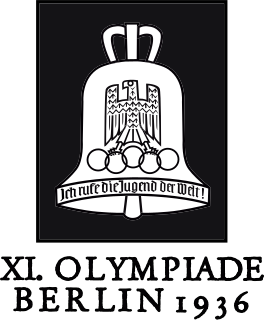
The 1936 Summer Olympics, officially known as the Games of the XI Olympiad and commonly known as Berlin 1936 or the Nazi Olympics, were an international multi-sport event held from 1 to 16 August 1936 in Berlin, Germany. Berlin won the bid to host the Games over Barcelona at the 29th IOC Session on 26 April 1931. The 1936 Games marked the second and most recent time the International Olympic Committee gathered to vote in a city that was bidding to host those Games. Later rule modifications forbade cities hosting the bid vote from being awarded the games.

The Battle of the Somme, also known as the Somme offensive, was a battle of the First World War fought by the armies of the British Empire and French Third Republic against the German Empire. It took place between 1 July and 18 November 1916 on both sides of the upper reaches of the Somme, a river in France. The battle was intended to hasten a victory for the Allies. More than three million men fought in the battle of whom one million were wounded or killed, making it one of the deadliest battles in human history.

Schaumburg is a village mostly in Cook County and partly in DuPage County in northeastern Illinois, United States. Per the 2020 Census, the population was 78,723. Schaumburg is around 28 miles (45 km) northwest of the Chicago Loop and 10 miles (16 km) northwest of O'Hare International Airport. It is part of the Golden Corridor.
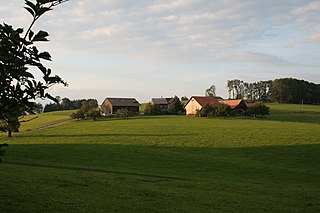
A hamlet is a small human settlement. In different jurisdictions and geographies, a hamlet may be the size of a town, village or parish, or may be considered to be a smaller settlement or subdivision or satellite entity to a larger settlement. The word and concept of a hamlet have roots in the Anglo-Norman settlement of England, where the old French hamlet came to apply to small human settlements. In British geography, a hamlet is considered smaller than a village and distinctly without a church or other place of worship. A hamlet may consist of a farm, mill or mine and all workers would generally be labouring here. There would be no, or if any, considerably basic services available to locals.
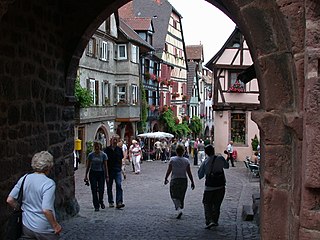
Riquewihr is a commune in the Haut-Rhin department in Grand Est in north-eastern France.

The Battle of Pozières took place in northern France around the village of Pozières, during the Battle of the Somme. The costly fighting ended with the British in possession of the plateau north and east of the village, in a position to menace the German bastion of Thiepval from the rear. The Australian official historian Charles Bean wrote that Pozières ridge "is more densely sown with Australian sacrifice than any other place on earth".
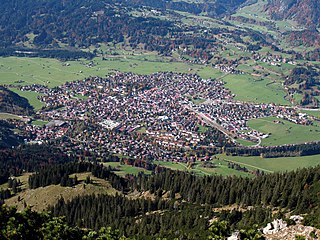
Oberstdorf is a municipality and skiing and hiking town in Germany, located in the Allgäu region of the Bavarian Alps. It is the southernmost settlement in Germany and one of its highest towns.
Bezirk Neunkirchen is a district of the state of Lower Austria in Austria. It is located at the south of the state.

In the Holy Roman Empire, a Gerichtslinde was a linden tree where assemblies and judicial courts were held. Rooted in Germanic tribal law, the custom has left traces through the Germanic language-speaking areas.

Gommecourt is a commune in the Pas-de-Calais department in the Hauts-de-France region of France.

Rhinau is a commune in the Bas-Rhin department of Grand Est in north-eastern France.
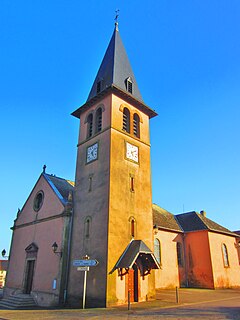
Launstroff is a commune in the Moselle department in Grand Est in north-eastern France.
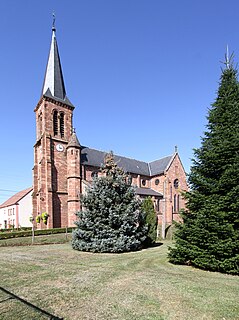
Haspelschiedt is a commune in the Moselle department of the Grand Est administrative region in north-eastern France. The population in 2018 was 301 inhabitants.

The River Tiddy is a small river in south-east Cornwall, the main tributary of the River Lynher. The Tiddy rises near Pensilva and flows south east past the village of Tideford until it joins the Lynher just after passing St Germans. The name of Tideford derives from its location on the river, literally meaning "Ford on the River Tiddy".
The Federal Inventory of Heritage Sites (ISOS) is part of a 1981 Ordinance of the Swiss Federal Council implementing the Federal Law on the Protection of Nature and Cultural Heritage.

The Itz is a river of Thuringia and Bavaria, Germany.

Göttingen is a university city in Lower Saxony, central Germany, the capital of the eponymous district. The River Leine runs through it. At the end of 2019, the population was 118,911.

Itzgründisch is an East Franconian dialect, which is spoken in the eponymous Itz Valley and its tributaries of Grümpen, Effelder, Röthen/Röden, Lauter, Füllbach and Rodach, the valleys of the Neubrunn, Biber and the upper Werra and in the valley of Steinach. In the small language area, which extends from the Itzgrund in Upper Franconia to the southern side of the Thuringian Highlands, East Franconian still exists in the original form. Because of the remoteness of the area, this isolated by the end of the 19th century and later during the division of Germany, this language has kept many linguistic features to this day. Scientific study of the Itzgründisch dialect was made for the first time, in the middle of the 19th century, by the linguist August Schleicher.





















